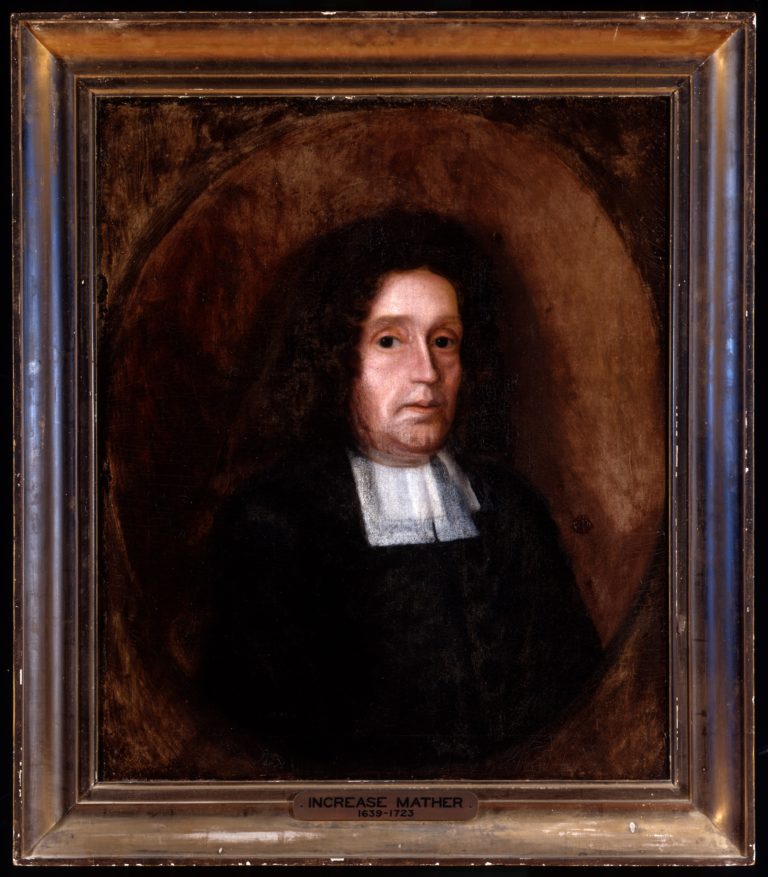An Arrow Against Profane and Promiscuous Dancing

Published in 1684, Increase Mather’s An Arrow Against Profane and Promiscuous Dancing Drawn out of the Quiver of the Scriptures is an example of the significant opposition to dancing in Puritan New England. Born in Dorchester, Massachusetts in 1639 and later educated at Harvard, Increase Mather became a minister as his father Richard Mather did before him. He saw the popularization of dance to be a threat to Puritanism and the founding mission of New England, perhaps most famously described by John Winthrop as an exemplary “citty upon a hill.”[1] Dancing masters – instructors of dance – were advertising their services in Boston, and many colonists found dance to be an enjoyable use of their leisure time. However, in the eyes of many Puritan leaders, dance was threatening the upstanding morality of New England, prompting Increase Mather’s passionately-written diatribe against dance in late seventeenth-century New England.
Increase Mather’s primary target was “Mixt or Promiscuous Dancing” of men and women together. He quoted Scripture’s warnings against dance through arguing that the Seventh Commandment prohibited dancing and through using several Biblical stories to describe its evils. Furthermore, “the Heathen” were the ones to make dancing a pastime, making it unacceptable that Puritans would partake of such immoral entertainment. In fact, New England writers occasionally described Native American dances as performances in which “the Devil appears in bodily shape,” reinforcing the godliness of Puritans in contrast to others they encountered.[2] In addition to his use of Scripture, Increase Mather also incorporated a common Puritan rhetoric of anti-popery. By portraying “papists” as ones who enjoyed dance and occasionally demoting it to a “venial sin,” Increase Mather worked to portray religious opposition as immoral and hypocritical, emphasizing the morality of Puritanism. However, with the popularization of dance, many Puritan leaders grew concerned that the dance popular among “papists” was also gaining popularity in New England. This preference suggested a significant threat to the religious superiority of Puritanism. Increase Mather and others used these well-known religious analogies and Biblical references to bolster their arguments against dance. They were unafraid to challenge what was deemed acceptable by society if it was unacceptable according to the Scriptures.
Well aware of the popularity of dancing among many Puritans, Increase Mather also strove to preclude arguments in favor of dance through a question and answer section in his pamphlet. One popular argument was that it encouraged “good Behaviour and decent Carriage” by teaching manners and grace. However, some were fearful that “mixt dancing” threatened people’s virtue and focused too much on appearance. The emphasis on mannerisms and appearance would inevitably encourage pride among dancers. In these many ways, religion was very closely tied to one’s choice of entertainment, and religion was one use of leisure time that became very controversial.
Increase Mather was not the only one to oppose dancing. Several other Puritan ministers, including his own son Cotton, would express their concerns. Following in the footsteps of his father, Cotton Mather also published a pamphlet against dance entitled “A Cloud of Witnesses.”[3] However, his criticism was slightly less severe than his father’s, evidence of the ever-growing popularity of dance among each new generation of Puritans. While opposition to dancing would continue to exist in the following decades, it slowly lost its power and popularity. By the eighteenth century, dance was becoming an increasingly popular pastime as well as a significant way for colonists – later Americans – to display their skills and etiquette in public. The very things that Increase Mather was so strongly against – colonists wasting their time on dancing, parents sending their children to learn from dancing masters, and men and women dancing together – became not only acceptable, but even encouraged. The Puritan legacy did not entirely vanish, however. Dancing masters’ advertisements in newspapers would often emphasize that they taught separate classes for boys and girls, while dancing assemblies and balls often posted strict rules of acceptable behavior. Nevertheless, dance became an increasingly acceptable part of colonial culture. In this way, the meaning of dance in American society took a significant turn – a change which Increase Mather saw coming and wanted to destroy with “An Arrow… Drawn from the Quiver of the Scriptures.” Within a century after Mather’s publication, colonial leaders not only accepted but enjoyed dance as an important aspect of American Revolution culture, even performing dances honoring the war’s heroes and battles. Thus, dance had not only grown in popularity, but become an important way for colonists to entertain themselves, display their class status through elaborate balls, and highlight their political leanings.
Further reading
“An Invitation to Dance: A History of Social Dance in America.” American Antiquarian Society. 2007.
Daniels, Bruce C. Puritans at Play: Leisure and Recreation in Colonial New England. New York: St. Martin’s Griffin, 1995.
Keller, Kate Van Winkle. Dance and its Music in America, 1528-1789. Hillsdale, NY: Pendragon Press, 2007.
Mather, Cotton. A Cloud of Witnesses; Darting Out Light upon a Case, too Unseasonably made Seasonable to be Discoursed on. Boston: B. Green and J. Allen?, 1700?.
Wagner, Ann. Adversaries of Dance: From the Puritans to the Present. Urbana and Chicago: University of Illinois Press, 1997.
[1] John Winthrop, “A Modell of Christian Charity,” in Collections of the Massachusetts Historical Society (Boston: 1630, 1838), 3rd series, 7: 47.
[2] Mather, 23.
[3] Cotton Mather, A Cloud of Witnesses; Darting Out Light upon a Case, too Unseasonably made Seasonable to be Discoursed on (Boston: B. Green and J. Allen?, 1700?).
This article originally appeared in issue 17.3 (Spring, 2017).
Laura Asson is a history PhD student at the University of Connecticut. Her research is on the role of music and dance in early America with a focus on the Revolutionary War. She studies both soldiers’ and civilians’ use of performing arts as a way to display their class status, adapt to war, and express their political loyalties